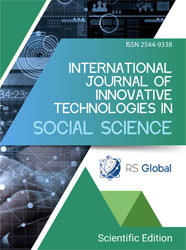POSTPARTUM OBSESSIVE-COMPULSIVE DISORDER: PREVALENCE, SYMPTOMS, OUTCOMES, AND TREATMENT APPROACHES: A COMPREHENSIVE REVIEW
Abstract
Introduction: Postpartum obsessive-compulsive disorder (PP-OCD) is a mental health condition that affects new mothers during a time of biological and emotional vulnerability. Characterized by intrusive obsessions, frequently involving fears of harming the infant, and accompanying compulsions such as checking or avoidance, PP-OCD can significantly impair maternal functioning. This review aims to synthesize current research regarding the prevalence, symptom profile, risk and protective factors, consequences, and treatment approaches for PP-OCD to improve diagnosis and intervention strategies.
Description of the state of knowledge: Prevalence estimates of PP-OCD vary widely, from 1.7% to 16.9%, depending on diagnostic criteria and methodology. Obsessions typically involve harm-related intrusive thoughts, while traditional OCD features like contamination concerns are less common. Risk factors include poor sleep, prior mental illness, high neuroticism, and maladaptive cognitive interpretations. Protective traits such as resilience and hyperthymic temperament may buffer risk. There is no evidence linking PP-OCD to actual infant harm. Treatments effective in general OCD, such as CBT with ERP and SSRIs, are applicable, though specific postpartum research is still limited. Preventive CBT-based interventions show emerging promise.
Conclusions: PP-OCD is a significant but underdiagnosed condition that impacts maternal well-being and can influence the bond between the infant and the mother. Increased awareness among healthcare providers and the public is essential, as misdiagnosing can lead to inappropriate care. Targeted screening, evidence-based treatments, and preventive strategies are crucial.
References
Stein, D. J., Costa, D. L. C., Lochner, C., Miguel, E. C., Reddy, Y. C. J., Shavitt, R. G., Van Den Heuvel, O. A., & Simpson, H. B. (2024). Author Correction: Obsessive–compulsive disorder. Nature Reviews Disease Primers, 10(1). https://doi.org/10.1038/s41572-024-00569-z
Goodman, J. H., Watson, G. R., & Stubbs, B. (2016). Anxiety disorders in postpartum women: A systematic review and meta-analysis. Journal of Affective Disorders, 203, 292–331. https://doi.org/10.1016/j.jad.2016.05.033
American Psychiatric Association. (2000). Diagnostic and statistical manual of mental disorders (4th ed., text rev.; DSM-IV-TR). Washington, DC: Author.
American Psychiatric Association. Diagnostic and statistical manual of mental disorders (5th ed., text rev.). American Psychiatric Association; 2022.
López-Solà, C., Fontenelle, L. F., Bui, M., Hopper, J. L., Pantelis, C., Yücel, M., Menchón, J. M., Alonso, P., & Harrison, B. J. (2015). Aetiological overlap between obsessive–compulsive related and anxiety disorder symptoms: Multivariate twin study. The British Journal of Psychiatry, 208(1), 26–33. https://doi.org/10.1192/bjp.bp.114.156281
Miller, E. S., Hoxha, D., Wisner, K. L., & Gossett, D. R. (2015). Obsessions and compulsions in postpartum women without obsessive compulsive disorder. Journal of Women S Health, 24(10), 825–830. https://doi.org/10.1089/jwh.2014.5063
Brok, E. C., Lok, P., Oosterbaan, D. B., Schene, A. H., Tendolkar, I., & Van Eijndhoven, P. F. (2017). Infant-Related intrusive thoughts of harm in the postpartum period. The Journal of Clinical Psychiatry, 78(8), e913–e923. https://doi.org/10.4088/jcp.16r11083
Hudepohl, N., MacLean, J. V., & Osborne, L. M. (2022). Perinatal Obsessive–Compulsive Disorder: Epidemiology, Phenomenology, Etiology, and Treatment. Current Psychiatry Reports, 24(4), 229–237. https://doi.org/10.1007/s11920-022-01333-4
Salari, N., Sharifi, S., Hassanabadi, M., Babajani, F., Khazaie, H., & Mohammadi, M. (2024). Global prevalence of obsessive-compulsive disorder in pregnancy and postpartum: a systematic review and meta-analysis. Journal of Affective Disorders Reports, 100846. https://doi.org/10.1016/j.jadr.2024.100846
Fawcett, E. J., Fairbrother, N., Cox, M. L., White, I. R., & Fawcett, J. M. (2019). The prevalence of anxiety disorders during pregnancy and the postpartum period. The Journal of Clinical Psychiatry, 80(4). https://doi.org/10.4088/jcp.18r12527
Russell, E. J., Fawcett, J. M., & Mazmanian, D. (2013). Risk of Obsessive-Compulsive Disorder in pregnant and postpartum women. The Journal of Clinical Psychiatry, 74(04), 377–385. https://doi.org/10.4088/jcp.12r07917
Fairbrother, N., Collardeau, F., Albert, A. Y. K., Challacombe, F. L., Thordarson, D. S., Woody, S. R., & Janssen, P. A. (2021). High prevalence and incidence of Obsessive-Compulsive Disorder among women across pregnancy and the postpartum. The Journal of Clinical Psychiatry, 82(2). https://doi.org/10.4088/jcp.20m13398
Miller, M. L., Roche, A. I., Lemon, E., & O’Hara, M. W. (2022). Obsessive–compulsive and related disorder symptoms in the perinatal period: prevalence and associations with postpartum functioning. Archives of Women S Mental Health, 25(4), 771–780. https://doi.org/10.1007/s00737-022-01239-3
Starcevic, V., Eslick, G. D., Viswasam, K., & Berle, D. (2020). Symptoms of obsessive-compulsive disorder during pregnancy and the postpartum period: a systematic review and meta-analysis. Psychiatric Quarterly, 91(4), 965–981. https://doi.org/10.1007/s11126-020-09769-8
Osnes, R. S., Eberhard-Gran, M., Follestad, T., Kallestad, H., Morken, G., & Roaldset, J. O. (2020). Mid-pregnancy insomnia is associated with concurrent and postpartum maternal anxiety and obsessive-compulsive symptoms: A prospective cohort study. Journal of Affective Disorders, 266, 319–326. https://doi.org/10.1016/j.jad.2020.01.140
Sedov, I. D., Cameron, E. E., Madigan, S., & Tomfohr-Madsen, L. M. (2017). Sleep quality during pregnancy: A meta-analysis. Sleep Medicine Reviews, 38, 168–176. https://doi.org/10.1016/j.smrv.2017.06.005
Radoš, S. N., Brekalo, M., Matijaš, M., & Žutić, M. (2025). Obsessive-compulsive disorder (OCD) symptoms during pregnancy and postpartum: prevalence, stability, predictors, and comorbidity with peripartum depression symptoms. BMC Pregnancy and Childbirth, 25(1). https://doi.org/10.1186/s12884-025-07302-y
Ferra, I., Bragança, M., & Moreira, R. (2024). Exploring the clinical features of postpartum obsessive-compulsive disorder- a systematic review. The European Journal of Psychiatry, 38(1), 100232. https://doi.org/10.1016/j.ejpsy.2023.100232
Yakut, E., Uguz, F., Aydogan, S., Bayman, M. G., & Gezginc, K. (2019). The course and clinical correlates of obsessive-compulsive disorder during the postpartum period: A naturalistic observational study. Journal of Affective Disorders, 254, 69–73. https://doi.org/10.1016/j.jad.2019.05.027
Blum, S., Mack, J. T., Weise, V., Kopp, M., Asselmann, E., Martini, J., & Garthus-Niegel, S. (2022). The impact of postpartum obsessive-compulsive symptoms on child development and the mediating role of the parent–child relationship: A prospective longitudinal study. Frontiers in Psychiatry, 13. https://doi.org/10.3389/fpsyt.2022.886347
Challacombe, F. L., Salkovskis, P. M., Woolgar, M., Wilkinson, E. L., Read, J., & Acheson, R. (2016). Parenting and mother-infant interactions in the context of maternal postpartum obsessive-compulsive disorder: Effects of obsessional symptoms and mood. Infant Behavior and Development, 44, 11–20. https://doi.org/10.1016/j.infbeh.2016.04.003
Ratzoni, N., Doron, G., & Frenkel, T. I. (2021). Initial evidence for symptoms of postpartum Parent-Infant Relationship Obsessive Compulsive Disorder (PI-ROCD) and associated risk for perturbed maternal behavior and infant social disengagement from mother. Frontiers in Psychiatry, 12. https://doi.org/10.3389/fpsyt.2021.589949
Fairbrother, N., Collardeau, F., Woody, S. R., Wolfe, D. A., & Fawcett, J. M. (2022). Postpartum thoughts of Infant-Related harm and Obsessive-Compulsive Disorder. The Journal of Clinical Psychiatry, 83(2). https://doi.org/10.4088/jcp.21m14006
McKay, D., Sookman, D., Neziroglu, F., Wilhelm, S., Stein, D. J., Kyrios, M., Matthews, K., & Veale, D. (2014). Efficacy of cognitive-behavioral therapy for obsessive–compulsive disorder. Psychiatry Research, 225(3), 236–246. https://doi.org/10.1016/j.psychres.2014.11.058
Misri, S., Reebye, P., Corral, M., & Milis, L. (2004). The use of paroxetine and Cognitive-Behavioral therapy in postpartum depression and anxiety. The Journal of Clinical Psychiatry, 65(9), 1236–1241. https://doi.org/10.4088/jcp.v65n0913
Challacombe, F. L., & Salkovskis, P. M. (2011). Intensive cognitive-behavioural treatment for women with postnatal obsessive-compulsive disorder: A consecutive case series. Behaviour Research and Therapy, 49(6–7), 422–426. https://doi.org/10.1016/j.brat.2011.03.006
Christian, L. M., & Storch, E. A. (2009). Cognitive behavioral treatment of postpartum onset. Clinical Case Studies, 8(1), 72–83. https://doi.org/10.1177/1534650108326974
Challacombe, F. L., Salkovskis, P. M., Woolgar, M., Wilkinson, E. L., Read, J., & Acheson, R. (2017). A pilot randomized controlled trial of time-intensive cognitive–behaviour therapy for postpartum obsessive–compulsive disorder: effects on maternal symptoms, mother–infant interactions and attachment. Psychological Medicine, 47(8), 1478–1488. https://doi.org/10.1017/s0033291716003573
Timpano, K. R., Abramowitz, J. S., Mahaffey, B. L., Mitchell, M. A., & Schmidt, N. B. (2011). Efficacy of a prevention program for postpartum obsessive–compulsive symptoms. Journal of Psychiatric Research, 45(11), 1511–1517. https://doi.org/10.1016/j.jpsychires.2011.06.015
Steinman, S. A., Edwards, C. B., Snider, M. D., Billingsley, A. L., Ponzini, G. T., Evey, K. J., Doss, B., & Timpano, K. R. (2024). Preventing Postpartum Anxiety and Obsessive-Compulsive Disorder Over the Internet: An Open-Trial Pilot study. Behavior Therapy, 56(1), 192–198. https://doi.org/10.1016/j.beth.2024.05.007
Pittenger, C., & Bloch, M. H. (2014). Pharmacological Treatment of Obsessive-Compulsive Disorder. Psychiatric Clinics of North America, 37(3), 375–391. https://doi.org/10.1016/j.psc.2014.05.006
Sharma, V., & Sommerdyk, C. (2015). Obsessive–Compulsive Disorder in the Postpartum Period: Diagnosis, Differential diagnosis and management. Women S Health, 11(4), 543–552. https://doi.org/10.2217/whe.15.20
Gentile, S. (2007). Use of Contemporary Antidepressants during Breastfeeding. Drug Safety, 30(2), 107–121. https://doi.org/10.2165/00002018-200730020-00002
Brakoulias, V., Viswasam, K., Dwyer, A., Raine, K. H., & Starcevic, V. (2020). Advances in the pharmacological management of obsessive-compulsive disorder in the postpartum period. Expert Opinion on Pharmacotherapy, 21(2), 163–165. https://doi.org/10.1080/14656566.2019.1700229
Ponzini, G. T., Snider, M. D., Evey, K. J., & Steinman, S. A. (2021). Women’s knowledge of postpartum anxiety disorders, depression, and cognitive Behavioral therapy. The Journal of Nervous and Mental Disease, 209(6), 426–433. https://doi.org/10.1097/nmd.0000000000001315
Mulcahy, M., Rees, C., Galbally, M., & Anderson, R. (2020). Health practitioners’ recognition and management of postpartum obsessive-compulsive thoughts of infant harm. Archives of Women S Mental Health, 23(5), 719–726. https://doi.org/10.1007/s00737-020-01026-y
Views:
7
Downloads:
2
Copyright (c) 2025 Izabella Sośniak, Ewa Szczęsna, Marta Miejska-Kamińska, Lidia Jurczenko

This work is licensed under a Creative Commons Attribution 4.0 International License.
All articles are published in open-access and licensed under a Creative Commons Attribution 4.0 International License (CC BY 4.0). Hence, authors retain copyright to the content of the articles.
CC BY 4.0 License allows content to be copied, adapted, displayed, distributed, re-published or otherwise re-used for any purpose including for adaptation and commercial use provided the content is attributed.















